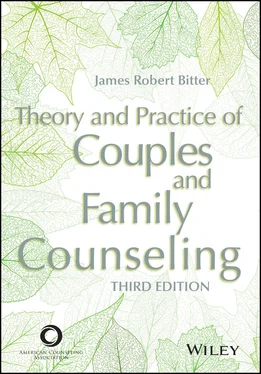James Robert Bitter - Theory and Practice of Couples and Family Counseling
Здесь есть возможность читать онлайн «James Robert Bitter - Theory and Practice of Couples and Family Counseling» — ознакомительный отрывок электронной книги совершенно бесплатно, а после прочтения отрывка купить полную версию. В некоторых случаях можно слушать аудио, скачать через торрент в формате fb2 и присутствует краткое содержание. Жанр: unrecognised, на английском языке. Описание произведения, (предисловие) а так же отзывы посетителей доступны на портале библиотеки ЛибКат.
- Название:Theory and Practice of Couples and Family Counseling
- Автор:
- Жанр:
- Год:неизвестен
- ISBN:нет данных
- Рейтинг книги:5 / 5. Голосов: 1
-
Избранное:Добавить в избранное
- Отзывы:
-
Ваша оценка:
- 100
- 1
- 2
- 3
- 4
- 5
Theory and Practice of Couples and Family Counseling: краткое содержание, описание и аннотация
Предлагаем к чтению аннотацию, описание, краткое содержание или предисловие (зависит от того, что написал сам автор книги «Theory and Practice of Couples and Family Counseling»). Если вы не нашли необходимую информацию о книге — напишите в комментариях, мы постараемся отыскать её.
Theory and Practice of Couples and Family Counseling — читать онлайн ознакомительный отрывок
Ниже представлен текст книги, разбитый по страницам. Система сохранения места последней прочитанной страницы, позволяет с удобством читать онлайн бесплатно книгу «Theory and Practice of Couples and Family Counseling», без необходимости каждый раз заново искать на чём Вы остановились. Поставьте закладку, и сможете в любой момент перейти на страницу, на которой закончили чтение.
Интервал:
Закладка:
5 Reviewing the process. This step starts with the family practitioner openly reflecting on all aspects of the ethical decision-making process in which the counselor is engaged:Would the family practitioner want to be treated this way?How are the values and personal characteristics of the family practitioner influencing the choices that have been made?What has been the effect of the family practitioner’s power in these ethical conversations?Have the clients’ perspectives been taken into account? (Rave & Larsen, 1995).Opening oneself to deliberate reflection may serve to check the credibility and trustworthiness of the constructed solution. It also models for clients the importance of self-reflection in this participatory process.
6 Implementing and evaluating the decision. Participatory ethics recognizes that ethical dilemmas force everyone into a state of vulnerability and sometimes anxiety (Coale, 1998). It is a model in which all parties participate in both the decision-making and the consequences of the decisions made. The process cannot end with the implementation of a decision: Evaluation and regular reevaluation are essential:Does the outcome continue to feel right?How has the decision affected the therapeutic process?Is the solution we chose the best we can do?
7 Continuing to reflect. The last step in the participatory ethics model returns the family practitioner to self-reflection and a consideration of the ethical decision-making process in a removed or disengaged space:What did I learn from the process about myself and about the participatory process?How might this experience affect me in the future?How, if at all, have I changed as a result of my participation in the process?The practitioner must not only examine the outcome for the client but also reflect on the decision’s impact in relation to themselves. Each and every decision made extends into the future, well beyond the current clients’ situation. Valuing personal and professional experiences of the process through continued reflection facilitates greater awareness and learning for the family practitioner and enhances the ethical process with future clients.
We have presented only three models of ethical decision-making here. What reactions do you have to each of them? What feelings surface? Your thoughts and feelings speak to the kind of person you want to be as a family practitioner.
Common Ethical Dilemmas in Couples and Family Practice
We now shift to a discussion of some of the most commonly encountered or constructed ethical dilemmas when working with couples and family members. Whole texts have been written addressing ethics in family practice (Golden, 2004; Herlihy & Corey, 2015; IAMFC, 2017; Murphy & Hecker, 2017; Wilcoxon et al., 2013; Woody & Woody, 2001): The most common dilemmas that surface are related to confidentiality, multiple clients, informed consent, and gender and multicultural issues. We now delineate some of the issues that family practitioners have faced in these four areas. This is not a comprehensive list, and there are no easy answers to propose. We touch on these issues so that you will know that you are not alone when you are confronted with similar ethical problems. Reflect on Sidebar 4.1.
Sidebar 4.1 • A Learning Challenge
Family practitioners actually have very little time to reflect on their place in ethical decision-making processes. Managed care has not found a way to reimburse self-awareness. Here is a challenge for you: Take a practicing family counselor to lunch and ask some of the questions we have asked you to consider. When finished, ask your companion what it was like to spend 30–60 minutes in conversation with you about such topics. Now, we are willing to bet that if you succeed in being genuinely curious during your questioning, the majority of family practitioners will say something like, “You know, I don’t get to do this very often. This was great! I wish I could find more time to do this.” Reflective conversations like these engage professionals in self-care, help to prevent burnout, and encourage ethical practices
Confidentiality
Trust in any therapeutic relationship is intimately tied to the guarantee of confidentiality. The ability to speak openly and with emotional honesty is supported by a trusting relationship that ensures a respect for privacy. This right to privacy in psychotherapy is recognized in all 50 states and by the federal government in HIPAA standards and Supreme Court decisions. But what degree of privacy can a family counselor or therapist truly uphold? Maintaining confidentiality can be an enormous responsibility for a practitioner working with just one person. When a counselor is working with multiple people in one room, the challenges to maintaining confidentiality increase exponentially. It is in the subtexts of confidentiality and family practice that ethical issues become extremely difficult, especially those of conceptualizing the client served, providing informed consent, and handling relational matters in an individual context.
Conceptualizing the Client
If your practice consists solely of individual clients, the definition of client is clear: It is the person sitting across from you in a counseling or therapy session. The more systemically oriented counselors, however, embrace the family as a whole as the client—with many, like Whitaker, insisting that all members of the family be present before therapy begins. The first practitioners of Bowen family therapy, structural family therapy, and the various strategic therapies emphasized family dynamics in which individuals were little more than parts of an interaction or actors in a systemic drama. In the past decade, there has been a concerted effort to reinstate the individual into family systems theories, with postmodern models tending to conceptualize families and clients as those individuals who are in conversation about any given problem. In these later models, those in conversation about a problem determine who needs to be involved in family sessions. 3What happens to confidentiality in these shifting conceptualizations of family is at the heart of one whole set of ethical concerns. Even within systemic orientations, there are those who choose to approach families not as one client but as multiple clients, a perspective that is assumed in most state laws.
Remley and Herlihy (2020) indicated that laws hold individuals, not the collection of people called a family , accountable for actions that may violate the freedom of others. This should not be surprising in a society that values individualism over collectivism. But it also has a similar impact on the more practical standards of practice involved in professional codes.
A clear example relates to the use of case notes in family practice. If the client is the family, there is one client. It is logical then that the family practitioner would write one set of case notes for the one client. But this is not necessarily so: IAMFC (2017), for example, suggests that “in situations involving multiple clients, couple and family counselors provide only the records directly related to a particular individual, protecting confidential information related to any other client” (p. 4). In both the law and this professional code, one family of five equals five individuals. To meet HIPAA standards, each individual has to have their own records, notes, consent, and other individual data. Having multiple clients in counseling or therapy thus has a direct impact on informed consent.
Informed Consent
AAMFT (2015) notes that confidentiality and informed consent are interrelated. Specific applications of confidentiality and its limitations need to be discussed early and often in treatment. Furthermore, the family practitioner and the clients need to agree on not only those limitations mandated by law but also those that the therapist may set for effective treatment.
Читать дальшеИнтервал:
Закладка:
Похожие книги на «Theory and Practice of Couples and Family Counseling»
Представляем Вашему вниманию похожие книги на «Theory and Practice of Couples and Family Counseling» списком для выбора. Мы отобрали схожую по названию и смыслу литературу в надежде предоставить читателям больше вариантов отыскать новые, интересные, ещё непрочитанные произведения.
Обсуждение, отзывы о книге «Theory and Practice of Couples and Family Counseling» и просто собственные мнения читателей. Оставьте ваши комментарии, напишите, что Вы думаете о произведении, его смысле или главных героях. Укажите что конкретно понравилось, а что нет, и почему Вы так считаете.












